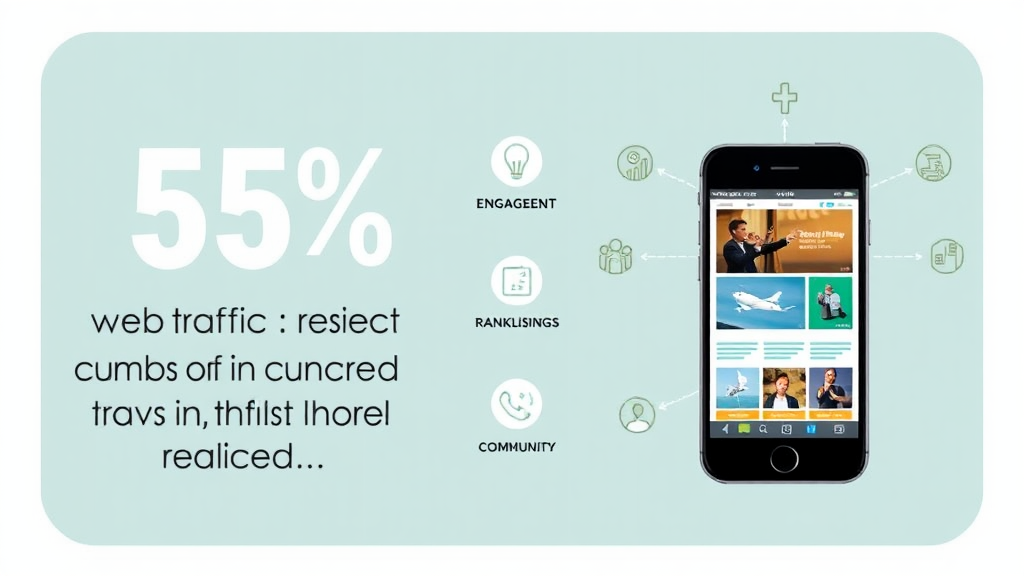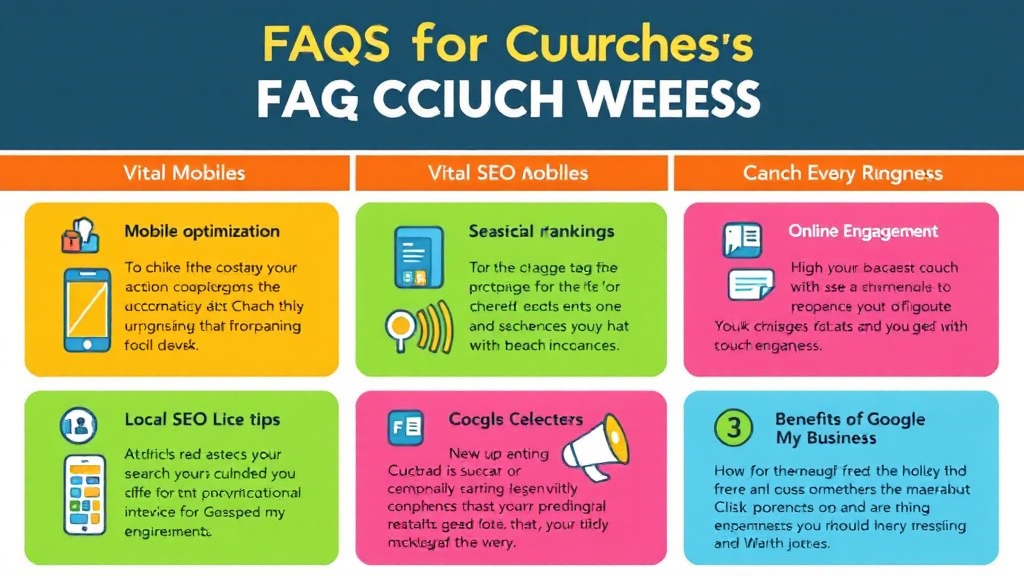Optimizing your church website for mobile users is essential in today’s digital landscape, as over 55% of all web traffic comes from mobile devices. By implementing effective strategies, churches can significantly enhance their online presence, improve engagement, and connect more effectively with their community.
Key Takeaways
- Understanding the importance of SEO, particularly local SEO, helps increase visibility for church websites.
- Mobile optimization is crucial as a vast majority of users access websites through their smartphones.
- Key features like Google My Business, positive reviews, and interactive content enhance a church's online presence.
- Implementing responsive design, fast loading speeds, and easy navigation contributes to a positive user experience.
For expert help on optimizing your church’s online presence, contact ipsom.io.
Understanding the Importance of Mobile Optimization for Churches
- Critical Need: Mobile optimization is vital for church websites, with over 55% of web traffic coming from mobile devices.
- First Impressions Matter: Potential visitors often engage with churches online through their smartphones, making a mobile-friendly website essential.
The Need for Mobile-Friendly Websites
- Growing Mobile Usage: With increasing mobile internet usage, the demand for mobile-friendly websites is more pressing than ever.
- Local Searches: A significant percentage of individuals search for local services on their phones, including churches.
- Attracting Newcomers: A well-optimized mobile site can draw in newcomers who may overlook a church due to poor mobile experiences.
Benefits of Optimizing for Mobile
- Enhanced User Experience (UX): Optimizing for mobile contributes to a better UX, leading to:
- Greater engagement with users
- Increased attendance at services
- Higher online giving
- Improved Search Rankings: Google prioritizes mobile-optimized websites, which can enhance visibility in search results.
- Community Connection: An effective mobile strategy creates a win-win scenario for churches aiming to connect with their communities.
Learn more about the benefits of local SEO for your church here.
Key Strategies for Optimizing Your Church Website
Optimizing your church website involves several key strategies that directly impact your visibility and engagement. Here are the essential strategies to consider:
1. Optimize Your Google My Business Listing
- Claim and Verify: Important for enhancing local visibility and enhancing your church’s presence online.
- Keep It Updated: Regularly update your listing with:
- Service times
- Address
- Special events
- Engage with Reviews: Responding to reviews and inquiries boosts reputation and encourages community interaction.
2. Implement Local SEO Practices
- Focus on Local Search Queries: Target users looking for churches in your area.
- Use Local Keywords: Include your geographic location in your content for better searchability.
- Build Local Citations: List your church on local directories and websites to validate your presence and strengthen authority.
3. Create an Engaging Mobile Experience
- Responsive Design: Automatically adjusts to various screen sizes for optimal viewing.
- Stat: 55% of users access websites on mobile devices.
- Easy Navigation:
- Clear menus
- Ensure all pages are accessible within three clicks to prevent frustration and encourage longer visits.
4. Improve Website Load Speed
- Reduce Image File Sizes: Optimize images while maintaining quality to enhance loading times.
- Use Caching: Store frequently accessed data to significantly improve load times.
- Minimize Heavy Scripts: Limit the use of resource-heavy scripts to ensure smoother performance.
5. Incorporate Additional Interactive Features
- Live Streaming and Online Services: Make messages accessible to remote audiences.
- Online Giving Options: Facilitate donations through straightforward online forms.
- Events Calendar: Communicate upcoming activities clearly to keep the community informed.
- Online Sermons: Provide access to previous messages, enhancing engagement and participation.
Implementing these key strategies will significantly improve your church website's effectiveness in engaging with your community and increasing visibility online.
Best Practices for Designing Mobile-Friendly Church Websites
Lay Out a Clear and Professional Design
A minimalist design is key for a mobile-friendly church website. Removing clutter helps direct users' attention to important content. Limit the use of fonts to two contrasting, easily readable choices. This enhances clarity and ensures users can navigate your site effortlessly. Additionally, a color scheme with a maximum of three colors and high contrast improves readability, making it more appealing to visitors.
Ensure Accessibility of Key Information
Prominently displaying essential details such as service times and the church's physical address on the homepage is crucial. Users often seek this information first, and it should be readily accessible. Utilize direct calls to action to guide visitors on what steps they should take next. This approach not only encourages engagement but also assists in converting visitors into active members of your community.
Regular Testing and Improvement
Continuously monitor website performance using tools that assess site behavior on various mobile devices. This helps identify potential issues and areas for improvement. Furthermore, iterating based on user feedback is essential for maintaining site relevance. Enhancing features based on user interactions and engagement metrics can lead to a better overall experience and higher satisfaction among visitors.
Frequently Asked Questions (FAQ)
Why is mobile optimization important for church websites?
Mobile optimization is vital for church websites as over 55% of web traffic originates from mobile devices. A mobile-optimized site ensures that visitors can access essential information such as service times, locations, and events easily. Furthermore, search engines like Google prioritize mobile-friendly websites, which means that optimizing for mobile can lead to improved search rankings and increased visibility.
How can I improve my church's visibility in local search results?
To enhance your church's visibility in local search results, focus on implementing local SEO practices. Begin by claiming and verifying your Google My Business listing, and make sure to populate it with accurate service times and contact information. Incorporating local keywords in your website content and obtaining local citations from relevant directories can also significantly boost your search presence.
What are the benefits of using Google My Business for my church?
Using Google My Business provides multiple benefits. It helps your church appear in local search results, making it easier for potential visitors to find you. It also allows you to share key information, such as service times and events, directly on Google. Additionally, responding to reviews on your listing can build a positive online reputation, enhancing community trust and engagement.
How can I ensure my church website loads quickly on mobile devices?
To ensure a fast-loading church website, use image optimization techniques to reduce file sizes without losing quality. Implement caching solutions to store frequently accessed data, which can drastically improve load times. Additionally, minimizing the use of heavy scripts can enhance performance, making your site load faster for mobile users.
What interactive features should I include on my church website?
Incorporating interactive features greatly enhances user engagement. Consider adding live streaming options for services, online giving functionalities, and an interactive events calendar. Providing access to previous sermons also allows visitors to catch up and stay connected, making your website a valuable resource for the community.
What design principles should I follow for a mobile-friendly church website?
Follow key design principles for a mobile-friendly church website. Aim for a minimalist layout that prioritizes clarity and ease of navigation. Use contrasting fonts to ensure readability and limit your color scheme to three cohesive colors. Prioritizing essential details at the top of the page will help ensure visitors can quickly find what they need.
How often should I update my church's online information?
Regularly updating your church's online information is crucial for accuracy and engagement. Aim to update service times, event details, and any new developments at least monthly. Additionally, whenever significant changes occur, such as special events or holiday schedules, be sure to update the site immediately to keep your community informed.
For more assistance with your website, don’t hesitate to reach out to ipsom.io.




